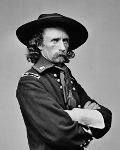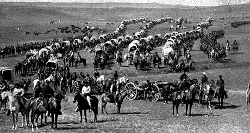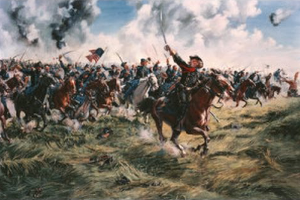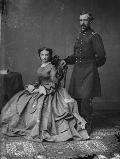George Armstrong Custer compiled an impressive military career but is most well-known for his historic and fatal defeat at the Battle of Little Bighorn. He was born on Dec. 5, 1839, in New Rumley, Ohio. Little is known of his early life. He did earn a teaching certificate, from a Normal School, but not enjoy teaching, preferring to pursue a military career. 
Accepted into the West Point Military Academy, he began in 1857 and graduated in June 1861, two months after the start of the Civil War. Custer had an affinity for the cavalry and found staff duty with the Army of the Potomac. He proved an able soldier, and Custer was promoted up the ranks, reaching the rank of brigadier general of volunteers, in charge of the Michigan Cavalry Brigade, within two years. He was major general by the time the war ended, and he had command of a division of cavalry. He saw action at some of the war's most pivotal moments. He was a courier for General Irvin McDowell at the First Battle of Bull Run. He served with General McClellan at the Battle of Antietam. He led a brigade during the Battle of Custer became known as risk-taker. During the Peninsula Campaign, when Gen. John Barnard stopped at the Chickahominy River in order to determine whether it was too deep for his force to cross, Custer found out for him by riding his horse out into the middle of the river, safely. He also became known for leading his men into battle, a practice not followed by everyone of his rank or even of lesser rank. He was often far out front of the rest of the men in his force, and he escaped death multiple times, sustaining an artillery shell wound at the Battle of Culpepper Courthouse and having 11 horses shot out from under him. He became known as having "Custer Luck." Soon enough, he believed that he had it. The end of the war brought the end of the volunteer army, and Custer left the war with the rank of captain. He wasn't done with the cavalry, though. He won a promotion to lieutenant colonel of the new 7th Cavalry Regiment, created at Fort Riley, in Kansas, in 1866. Custer served in that capacity for 20 years and was effectively in charge of the regiment because his commanders were not often there. Custer went with Major General Winfield Hancock and a contingent of soldiers on a peace campaign along the Arkansas River in 1867, to negotiate with representatives of the Cheyenne and Kiowa tribes. That wasn't the only action for which he was prosecuted. Among the charges as well were allegations that he refused to give medical attention to deserters and that he ordered them shot without trial. He was found guilty on all charges and suspended from rank without pay for a year. Custer ended up serving less than the full suspension because Major General Philip Sheridan, himself a distinguished cavalry veteran of the Civil War, wanted Custer to accompany him on a campaign against Cheyenne. Again in the Arkansas River Valley, this time in Oklahoma, Custer, this time in charge of the 7th Cavalry, led an attack on Chief Black Kettle's village in the Battle of the Washita, on Nov. 27, 1868. The dawn raid resulted in the deaths of Black Kettle and many other Cheyenne, women and children among them. Five years later, Custer saw similar action, called in to deal with Lakota Sioux and others in the Yellowstone River area who were interfering with the construction of the Northern Pacific Railroad. Custer's men's task this time was protecting the railroad survey; among the raiding parties were the famous Crazy Horse and the equally famous Sitting Bull. 
One year later, in 1874, Custer led a 1,200-man expedition into the Black Hills of South Dakota, in order to determine the best location to build a fort to help protect an influx of settlers against raiders from area Lakota. Gold was discovered, making the cavalry expedition timely indeed. Custer found himself embroiled in a political scandal in 1875 and 1876. It turned out that Secretary of War William Belknap had been selling trading rights at forts and posts along the upper Missouri River. Custer's testimony also named Orville Grant, brother of President Ulysses S. Grant as someone involved in the scandal. A furious Grant relieved Custer of his post but relented under public pressure. Nonetheless, Custer was second-in-command, under General Alfred Terry, of a cavalry contingent in the spring of 1876, accompanying an artillery and infantry force whose goal to convince a large number of Cheyenne and Lakota to move to the Great Sioux Reservation. Custer and the 7th Cavalry set out ahead of the rest on June 22. Three days later, he arrived at what he thought was a village. As he had done during his Civil War days, he had been too quick off the mark and was way out in front of the rest of the force. John Gibbon's infantry was naturally slower moving, but they were very far behind. General Crook's artillery wasn't coming at all, having been turned at Rosebud Creek by a large force led by Crazy Horse. 
Custer lost his life that day. What he thought was a village was a veritable sea, a group of thousands of Arapaho, Cheyenne, and Lakota, led by Sitting Bull. Hearing that they were about to flee, Custer divided his men into three in order to prevent the enemy escaping and then, despite having no reinforcements, ordered an attack, counting on his usual luck. He did not find it. At the end of the day at the Battle of Little Bighorn, more than 260 members of the 7th Cavalry, George Armstrong Custer and his brothers Boston and Tom among them, lay dead. No more than 80 Cheyenne and Lakota had died. The sole surviving member of Custer's force was Comanche, a horse. Libbie Custer continued to tell stories of her husband's bravery and gallantry until she died, nearly 60 years later. She wrote a series of books about their life together, all of which became best-sellers. Custer's Last Stand, as it became known, proved irresistible as a plot device for books and films about the American experience in the West. |
|
Social Studies for Kids
copyright 2002–2025
David White



 Gettysburg
Gettysburg The expedition saw no combat, but Custer had plenty of conflict when it was over. In 1862, in the middle of the Civil War, he had met Elizabeth "Libbie" Bacon, a woman with whom he was quite smitten quite soon. Her father, Judge Daniel Bacon, did not approve of his daughter marrying someone like Custer, who at that time had a relatively low rank; the judge came around in 1864, when Custer had achieved the rank of brigadier general, and George and Libbie were married. The pair wrote letters to each other again and again as the war raged and took every opportunity to spend time together. He became so desperate to see his wife in 1867 that he went away without leave (AWOL) and ended up being court-martialed for his transgression.
The expedition saw no combat, but Custer had plenty of conflict when it was over. In 1862, in the middle of the Civil War, he had met Elizabeth "Libbie" Bacon, a woman with whom he was quite smitten quite soon. Her father, Judge Daniel Bacon, did not approve of his daughter marrying someone like Custer, who at that time had a relatively low rank; the judge came around in 1864, when Custer had achieved the rank of brigadier general, and George and Libbie were married. The pair wrote letters to each other again and again as the war raged and took every opportunity to spend time together. He became so desperate to see his wife in 1867 that he went away without leave (AWOL) and ended up being court-martialed for his transgression.
